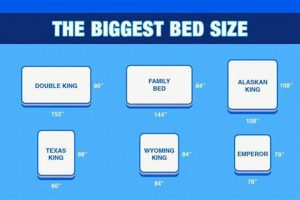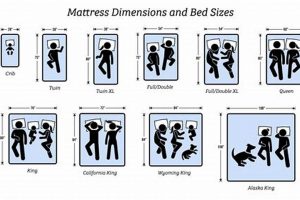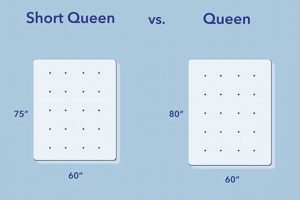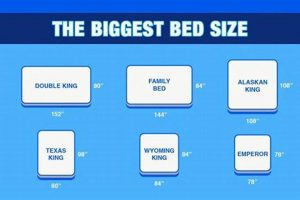The vertical dimension of a mattress, expressed in inches, dictates its profile. Measurements typically range from a minimal 5 inches to upwards of 16 inches. For example, a mattress measuring 10 inches in height would be considered a medium profile.
This dimension significantly impacts overall sleep comfort and aesthetics within the bedroom. Proper selection ensures appropriate bed height, easing entry and exit. Historically, shallower mattresses were common; contemporary designs often incorporate thicker comfort layers for enhanced support and pressure relief.
Subsequently, the following sections will detail the specific categories of mattress profiles, their suitability for various needs, and key considerations for making an informed purchase.
Considerations for Mattress Profile Selection
The subsequent guidelines are provided to aid in selecting an appropriate mattress profile, optimizing both comfort and practicality.
Tip 1: Assess Bed Frame Compatibility: Measure the existing bed frame’s internal dimensions to ensure the selected mattress profile fits securely and aesthetically. A mismatch can lead to instability or an undesirable visual effect.
Tip 2: Evaluate Foundation Height: Account for the height of the bed foundation or box spring. A higher foundation paired with a deep mattress profile may result in an excessively tall bed, potentially posing challenges for individuals with mobility concerns.
Tip 3: Prioritize Sleep Position: Individuals who primarily sleep on their side may benefit from a thicker mattress profile offering increased cushioning for pressure points. Conversely, stomach sleepers may find a lower profile more supportive.
Tip 4: Account for Body Weight: Higher body weight often necessitates a deeper mattress profile to prevent bottoming out and ensure adequate support. Lower body weight may find sufficient support in a shallower profile.
Tip 5: Consider Sheet Fit: Deeper mattress profiles require fitted sheets with deeper pockets. Ensure that existing or newly purchased sheets are compatible with the chosen mattress profile to prevent slipping or tearing.
Tip 6: Analyze Room Aesthetics: The mattress profile contributes to the overall visual balance of the bedroom. A disproportionately tall or shallow mattress can disrupt the desired aesthetic.
Tip 7: Evaluate Edge Support: Deeper mattress profiles often, though not always, provide enhanced edge support, preventing roll-off and maximizing the usable sleep surface.
In summary, selecting the correct mattress profile involves careful consideration of multiple factors, ranging from practical compatibility to individual sleep preferences. A well-chosen profile can significantly enhance sleep quality and overall satisfaction.
The following sections will further elaborate on specific mattress types and their corresponding profile characteristics.
1. Profile Height
Profile height, a critical attribute of mattress depth sizes, determines the overall stature and aesthetic presence of a mattress. Its influence extends beyond mere visual impact, affecting accessibility, support, and the compatibility of bedding accessories.
- Impact on Accessibility
The profile height directly influences the ease with which individuals can enter and exit a bed. A taller profile, when combined with a standard bed frame, may present challenges for shorter individuals or those with mobility limitations. Conversely, a lower profile might necessitate a higher foundation to achieve a comfortable bed height. Ergonomic considerations should dictate profile selection based on individual needs.
- Influence on Support and Comfort
While not the sole determinant of support, profile height often correlates with the quantity and arrangement of comfort layers within a mattress. Deeper profiles frequently accommodate thicker layers of memory foam or latex, providing enhanced pressure relief and conforming to the body’s contours. However, the overall construction and materials also significantly contribute to the perceived comfort level.
- Bedding Compatibility Considerations
Mattress profile height dictates the required depth of fitted sheets. Standard sheets may not adequately accommodate deeper mattress profiles, leading to slippage or tearing. Deep-pocket sheets are specifically designed for mattresses with greater depth. Failure to consider this compatibility can result in frustration and additional expense.
- Aesthetic Integration within Bedroom Design
The profile height affects the overall visual balance and aesthetic harmony within the bedroom. A disproportionately tall or shallow mattress can disrupt the desired look and feel. Consider the existing furniture and architectural elements when selecting a profile height to ensure a cohesive and visually appealing environment. Lower profile mattresses often provide a more modern aesthetic, while higher profiles can lend a sense of grandeur.
In conclusion, profile height is an integral component of mattress depth sizes, impacting functionality, comfort, and aesthetics. Its selection should be predicated on a holistic assessment of individual requirements, existing furniture, and desired bedroom design.
2. Sheet compatibility
Sheet compatibility, a critical consideration often overlooked, is directly determined by mattress depth sizes. The variance in vertical mattress dimensions necessitates careful attention to ensure proper sheet fit and prevent functional or aesthetic compromises.
- Pocket Depth Determination
Fitted sheets are characterized by their pocket depth, the measurement from the sheet’s corner to the elastic hem. This dimension must exceed the mattress depth to guarantee secure anchoring. Standard sheets, typically designed for mattresses up to 12 inches deep, will invariably fail on thicker mattresses, leading to slippage and inadequate coverage. Deeper mattresses require sheets specifically labeled as ‘deep pocket’ or ‘extra deep pocket.’
- Material Strain and Longevity
Attempting to stretch standard sheets over a mattress exceeding their intended capacity introduces undue strain on the fabric. This stress accelerates wear and tear, diminishing the sheet’s lifespan and increasing the likelihood of rips or tears. Appropriate sheet selection, predicated on accurate mattress depth measurements, preserves the integrity of the bedding investment.
- Aesthetic Considerations
Even if stretched to the limit, an improperly fitted sheet will exhibit visible signs of tension, creating an unsightly appearance. The stretched fabric may also compromise the smooth surface intended for comfortable sleep. Appropriately sized sheets, conversely, present a tailored, wrinkle-free aesthetic, contributing to a more refined bedroom environment.
- Functional Performance and Comfort
Sheets that are too small are more prone to slipping off the mattress during sleep. This disruption compromises sleep quality and necessitates frequent readjustment. Ill-fitting sheets can also bunch or wrinkle, creating pressure points and diminishing overall comfort. Selecting sheets with adequate pocket depth ensures a secure and comfortable sleep surface.
In summary, the interplay between mattress depth sizes and sheet compatibility is paramount. Failure to align sheet pocket depth with mattress dimensions results in compromised aesthetics, reduced sheet longevity, and diminished sleep quality. Therefore, precise measurement and informed sheet selection are indispensable for optimal bedding performance.
3. Foundation Height
Foundation height exerts a direct influence on the perceived and functional height of a sleep system, inextricably linked to mattress depth sizes. A low-profile mattress coupled with a high foundation yields a total bed height comparable to that of a deep mattress paired with a minimal foundation. This relationship is not merely additive; it has implications for accessibility, aesthetics, and biomechanical considerations.
The selection of foundation height should, therefore, be predicated on the mattress depth and the intended user’s physical characteristics. For individuals with limited mobility, a lower combined height, often achieved through a shallower foundation supplementing a standard mattress, facilitates easier ingress and egress. Conversely, a taller individual might benefit from an elevated combined height, requiring a deeper foundation alongside a thinner mattress. A common example is the use of a platform bed frame, effectively eliminating the need for a traditional foundation, thereby influencing the overall height perception and support characteristics of the sleep system.
Ultimately, understanding the interplay between foundation height and mattress depth sizes is paramount for creating a sleep environment that promotes both comfort and functionality. A miscalculation can result in a bed that is either too high, leading to potential safety concerns, or too low, causing discomfort during use. Therefore, careful measurement and consideration of individual needs are essential for optimizing the sleep experience.
4. Weight distribution
Weight distribution, intrinsically linked to mattress depth sizes, dictates the support and comfort a mattress provides. A deeper mattress, characterized by its greater vertical dimension, often incorporates multiple layers of varying densities. These layers are designed to accommodate and redistribute body weight across the sleep surface. Insufficient depth can result in concentrated pressure points, leading to discomfort and potential sleep disruption. For instance, a lightweight individual may experience adequate support on a thinner mattress, while a heavier person would likely require a deeper mattress to prevent bottoming out and maintain spinal alignment. The design and layering within the mattress are intended to uniformly distribute load and promote healthy sleep posture.
The impact of weight distribution extends to the mattress’s durability and longevity. A mattress adequately designed for the user’s weight will maintain its structural integrity over time, resisting sagging and compression. Conversely, an inappropriately sized mattress can exhibit premature wear, particularly in areas of concentrated pressure. Consider a scenario where a couple with a significant weight disparity shares a mattress; a deeper mattress with targeted support zones can mitigate the effects of uneven weight distribution, ensuring both individuals receive adequate support. This contrasts with a shallower mattress, which may conform excessively to the heavier partner, compromising support for the lighter one. Furthermore, proper weight distribution reduces motion transfer, particularly relevant for couples, ensuring that movement on one side of the bed does not significantly disturb the other.
In summary, mattress depth sizes significantly influence weight distribution and, subsequently, sleep quality. Selecting a mattress with an appropriate depth, factoring in individual weight and sleeping preferences, is essential for achieving optimal comfort and promoting long-term mattress durability. The challenges associated with improper weight distribution can be mitigated through informed selection, emphasizing the practical significance of understanding this relationship within the context of mattress depth.
5. Edge support
Edge support, referring to the structural reinforcement along the perimeter of a mattress, often correlates positively with mattress depth sizes. Deeper mattresses tend to offer enhanced edge support due to the increased volume of materials and the potential for more complex construction techniques. The absence of adequate edge support can lead to a feeling of instability when sitting or sleeping near the edge, effectively reducing the usable sleep surface. This effect is particularly pronounced in thinner mattresses where the edge may compress significantly under weight, creating a sensation of rolling off. For instance, a 14-inch hybrid mattress incorporating reinforced coils at its edges will likely provide superior edge support compared to an 8-inch memory foam mattress lacking such reinforcement.
The practical significance of edge support extends beyond mere comfort; it also impacts the longevity and structural integrity of the mattress. Reinforced edges help maintain the mattress’s shape over time, preventing sagging and ensuring consistent support across the entire surface. Consider a situation where an individual frequently sits on the edge of the bed to dress or read. A mattress with poor edge support will exhibit accelerated wear and tear in these areas, potentially leading to premature failure. Furthermore, strong edge support facilitates easier entry and exit, particularly beneficial for individuals with mobility limitations. Proper edge support helps distribute weight evenly, lessening pressure at the center.
Ultimately, the relationship between mattress depth sizes and edge support underscores the importance of considering overall construction when evaluating a mattress. While increased depth often correlates with improved edge support, it is not the sole determining factor. Construction techniques, such as the incorporation of reinforced coils or high-density foam, play a critical role. Consumers should assess edge support by testing the mattress in-store and considering individual needs and sleeping habits to ensure optimal comfort and long-term satisfaction with their purchase.
Frequently Asked Questions
The following questions address common inquiries regarding mattress depth, aiming to clarify its significance and impact on sleep quality.
Question 1: Does mattress depth size directly correlate with mattress quality?
Mattress depth size alone does not guarantee quality. While deeper mattresses often incorporate more advanced comfort layers and support systems, overall construction, materials, and design are more reliable indicators of quality.
Question 2: How does mattress depth size affect the required sheet size?
Mattress depth size directly dictates the necessary pocket depth of fitted sheets. Standard sheets are typically inadequate for mattresses exceeding 12 inches in depth, necessitating the purchase of deep-pocket sheets.
Question 3: Can a shallow mattress depth size provide adequate support for heavier individuals?
Shallow mattresses may not provide sufficient support for heavier individuals. Deeper mattresses, with their increased material volume and support structures, are generally better suited to accommodate higher weights and maintain spinal alignment.
Question 4: Does a deeper mattress depth size always equate to greater comfort?
While depth can contribute to comfort through enhanced cushioning, it is not the sole determinant. The specific materials, firmness level, and construction methods play equally significant roles in overall comfort.
Question 5: How does mattress depth size impact the overall height of the bed?
Mattress depth size is a primary factor in determining bed height. A deeper mattress paired with a standard foundation will result in a taller bed, potentially affecting accessibility for some individuals.
Question 6: Is edge support always superior in deeper mattress depth sizes?
While deeper mattresses often provide better edge support, it is not a universal rule. Edge support depends on specific construction techniques, such as reinforced coils or high-density foam, rather than solely on mattress depth.
In summary, mattress depth is one of many key considerations. The ideal depth depends on individual needs and preferences.
The next section will provide insight regarding related products and accessories.
Conclusion
This exploration of mattress depth sizes underscores its importance in achieving optimal sleep quality and overall bed functionality. Factors such as sheet compatibility, weight distribution, foundation height, and edge support are inextricably linked to this dimension. A comprehensive understanding of these elements ensures informed purchase decisions.
Therefore, careful consideration of mattress depth sizes is not merely an aesthetic choice but a fundamental step towards a comfortable and supportive sleep environment. The informed consumer recognizes the significance of this factor, leading to increased satisfaction and improved well-being.







